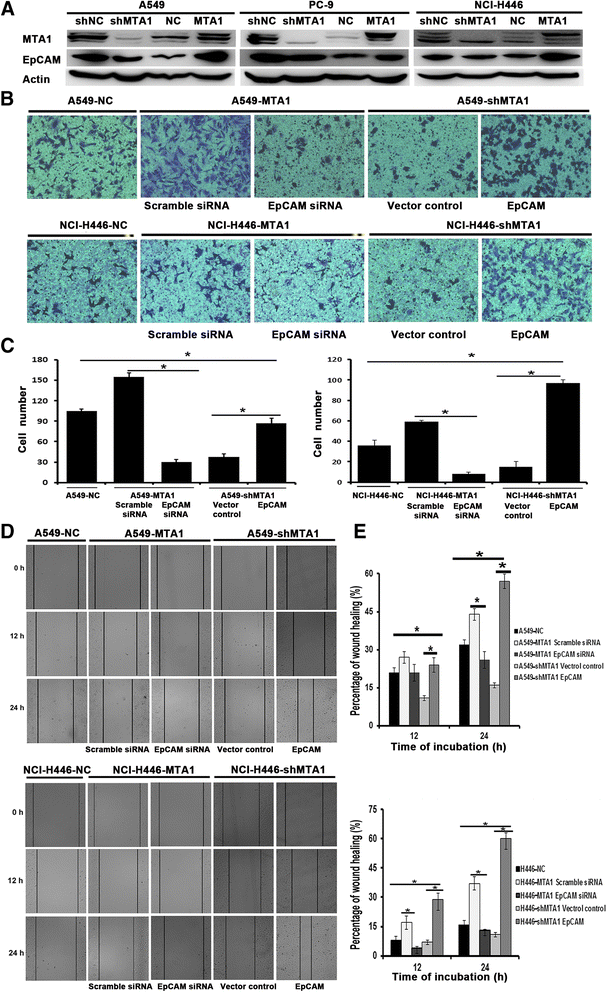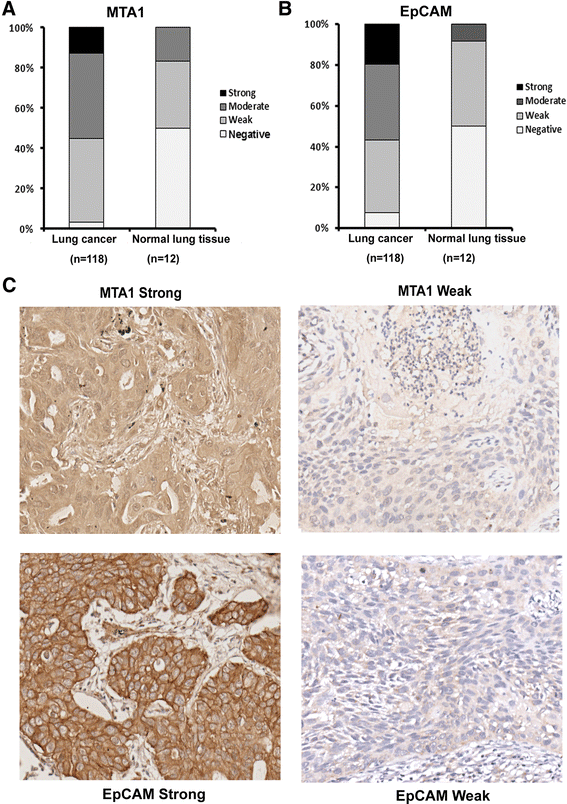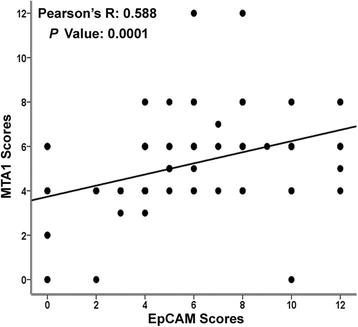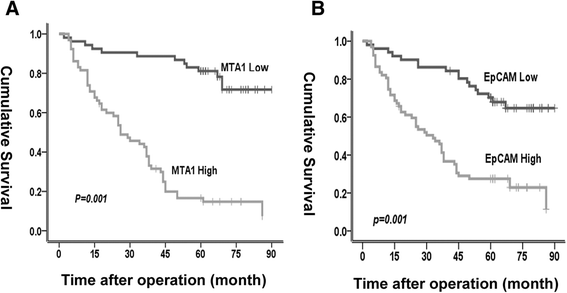MTA1-upregulated EpCAM is associated with metastatic behaviors and poor prognosis in lung cancer
- PMID: 26698569
- PMCID: PMC4690245
- DOI: 10.1186/s13046-015-0263-1
MTA1-upregulated EpCAM is associated with metastatic behaviors and poor prognosis in lung cancer
Abstract
Background: Overexpression of Metastasis-associated protein 1 (MTA1) in various cancer cells promotes tumor invasion and migration and predicts cancer patients' poor prognosis. The pilot RNA-Seq data from our laboratory indicated that Epithelial cell adhesion molecule (EpCAM) was statistically reduced in MTA1-silencing cells. EpCAM has been recognized as more than a mere cell adhesion molecule and recent findings have revealed its causal role in mediating migratory and invasive capacity. Thus, this study was aimed to explore whether MTA1 was able to upregulate EpCAM expression and, consequently, modulate its effects on invasion and migration of the lung cancer cells as well as patients' prognosis.
Methods: We checked the EpCAM expression by overexpressing or silencing MTA1 in lung cancer cells. Furthermore, these lung cancer cells with stably overexpressed or silenced MTA1 were transfected with siEpCAM or EpCAM-expressing plasmids and then subjected to western blot, invasion and migration assays. In addition, patients (n = 118) with early-stage lung cancer were enrolled in this study to confirm the correlations between MTA1 and EpCAM and pathoclinical parameters by using immunohistochemistry (IHC). All statistical analyses were performed with SPSS 20.0 statistical software.
Results: MTA1 upregulated EpCAM expression in lung cancer cell lines, and EpCAM overexpression rescued the inhibitory effects by silencing MTA1 on cell invasion and migration in vitro. What's more, both MTA1 and EpCAM, correlated to each other, were overexpressed in lung cancer tissues and significantly correlated with their clinical stages, tumor diameters, lymph node metastasis. Multivariate analysis indicated that local advancement (p = 0.03), MTA1 overexpression (p = 0.001) and EpCAM overexpression (p = 0.045) of the lung cancer tissues remained significant in predicting unfavorable overall survival.
Conclusions: We revealed a new molecular mechanism of MTA1-mediated invasion and metastasis in lung cancer through downstream target EpCAM, and interfering with EpCAM function may be a novel therapeutic strategy for treatment of MTA1-overexpressing lung carcinoma.
Figures




Similar articles
-
MTA1 promotes metastasis of MPM via suppression of E-cadherin.J Exp Clin Cancer Res. 2015 Dec 21;34:151. doi: 10.1186/s13046-015-0269-8. J Exp Clin Cancer Res. 2015. PMID: 26689197 Free PMC article.
-
MTA1 promotes epithelial to mesenchymal transition and metastasis in non-small-cell lung cancer.Oncotarget. 2017 Jun 13;8(24):38825-38840. doi: 10.18632/oncotarget.16404. Oncotarget. 2017. PMID: 28418915 Free PMC article.
-
Silencing MTA1 by RNAi reverses adhesion, migration and invasiveness of cervical cancer cells (SiHa) via altered expression of p53, and E-cadherin/β-catenin complex.J Huazhong Univ Sci Technolog Med Sci. 2011 Feb;31(1):1-9. doi: 10.1007/s11596-011-0141-9. Epub 2011 Feb 19. J Huazhong Univ Sci Technolog Med Sci. 2011. PMID: 21336715
-
Tumor metastasis-associated human MTA1 gene and its MTA1 protein product: role in epithelial cancer cell invasion, proliferation and nuclear regulation.Clin Exp Metastasis. 2003;20(1):19-24. doi: 10.1023/a:1022534217769. Clin Exp Metastasis. 2003. PMID: 12650603 Review.
-
Role of MTA1 in head and neck cancers.Cancer Metastasis Rev. 2014 Dec;33(4):953-64. doi: 10.1007/s10555-014-9521-5. Cancer Metastasis Rev. 2014. PMID: 25359583 Review.
Cited by
-
MTA1 is an indicator of prognosis in Chinese patients with lung adenocarcinoma.Transl Cancer Res. 2020 Mar;9(3):1625-1629. doi: 10.21037/tcr.2020.01.68. Transl Cancer Res. 2020. PMID: 35117510 Free PMC article.
-
Functional Implications of the Dynamic Regulation of EpCAM during Epithelial-to-Mesenchymal Transition.Biomolecules. 2021 Jun 29;11(7):956. doi: 10.3390/biom11070956. Biomolecules. 2021. PMID: 34209658 Free PMC article. Review.
-
Cancer Stem Cells-Origins and Biomarkers: Perspectives for Targeted Personalized Therapies.Front Immunol. 2020 Aug 7;11:1280. doi: 10.3389/fimmu.2020.01280. eCollection 2020. Front Immunol. 2020. PMID: 32849491 Free PMC article. Review.
-
Nanomaterial-based detection of circulating tumor cells and circulating cancer stem cells for cancer immunotherapy.Nano Converg. 2024 Dec 13;11(1):56. doi: 10.1186/s40580-024-00466-x. Nano Converg. 2024. PMID: 39671082 Free PMC article. Review.
-
High Expression of MTA1 Predicts Unfavorable Survival in Patients With Oral Squamous Cell Carcinoma.In Vivo. 2021 Jul-Aug;35(4):2363-2368. doi: 10.21873/invivo.12513. In Vivo. 2021. PMID: 34182519 Free PMC article.
References
-
- Allemani C, Weir HK, Carreira H, Harewood R, Spika D, Wang XS, et al. Global surveillance of cancer survival 1995–2009: analysis of individual data for 25,676,887 patients from 279 population-based registries in 67 countries (CONCORD-2) Lancet. 2015;385:977–1010. doi: 10.1016/S0140-6736(14)62038-9. - DOI - PMC - PubMed
-
- Li SH, Tian H, Yue WM, Li L, Li WJ, Chen ZT, et al. Overexpression of Metastasis-Associated Protein 1 is Significantly Correlated with Tumor Angiogenesis and Poor Survival in Patients with Early-Stage Non-Small Cell Lung Cancer. Ann Surg Oncol. 2011;18:2048-2056. - PubMed
Publication types
MeSH terms
Substances
LinkOut - more resources
Full Text Sources
Other Literature Sources
Medical
Research Materials
Miscellaneous

